
Walking the Fence – I photographed this horse walking along the fence from a distance, framing the shot with leaves on top and shadows at the bottom. I took many pictures from this spot; this one worked best because of the position of the horse's legs. 
Self Portrait: Photographer and Friend – When I noticed these strong shadows, I couldn't resist the chance to make a picture of myself with my equine model. One of our shooting assignments on this ranch was to make a picture that used high contrast to abstract the image. This shot does just that. 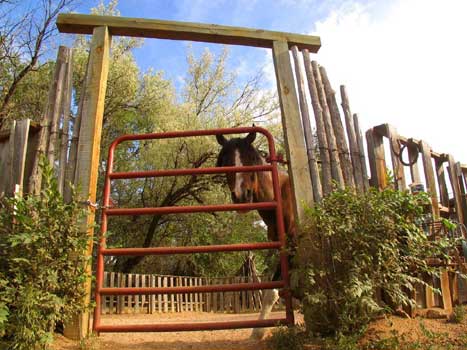
Inquisitive Horse – This horse was pacing back and forth around his corral, stopping to peer at me each time he came to the gate. Knowing what he was going to do, I backed up to include the entire gate and part of the fence in my frame and waited for him to stop and stare at me. The shot met another challenge of this assignment – stopping action to tell a story. 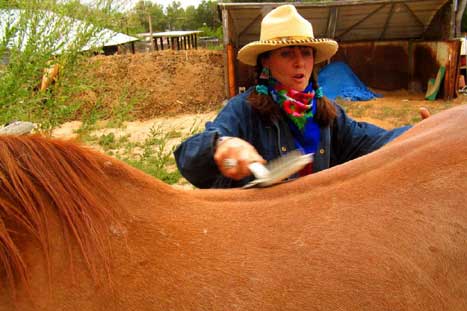
Brush Down – One of the owners of this ranch brushes down a horse before riding him. Expressing action was, as usual, among our assignments here. I used a slower shutter speed than normal to allow both the hand and the brush to blur. Yet the shutter speed remained fast enough to capture her enthusiastic expression. 
On the Move – Another ranch assignment was using a technique called panning to express movement. As this rider and horse rushed towards me, I slowly moved the camera horizontally while making this picture. My slow shutter speed completely blurred the background, yet I was still able to retain the moving forms of both horse and rider. I also deliberately underexposed the picture to emphasize the oncoming storm clouds.
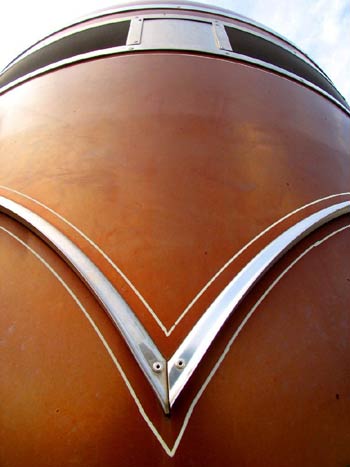
What is It? – Sometimes we can make pictures that ask questions of the viewer. While shooting around this ranch, we were asked to express ideas and feelings by taking unconventional vantage points. I moved in and crouched low at the rear of a horse trailer to create this abstract image. 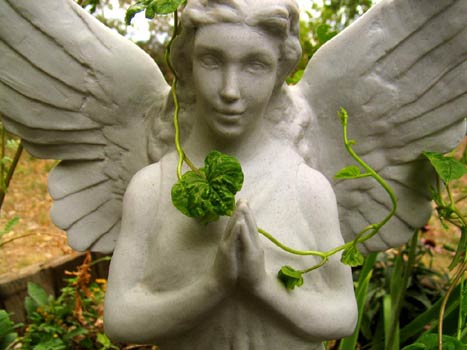
Getting Close to an Angel – While shooting at this ranch, we were given an assignment to find close-up images that expressed ideas. I noticed a tiny statue of an angel surrounded by plants. A vine was growing around it, carrying a heart-shaped leaf to the angel's chest. I moved to within a foot of the statue to make this picture. 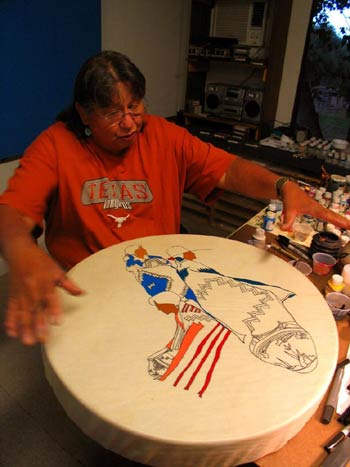
Artist at Work – Amato Peña Jr, a well known Santa Fe artist, was one of the owners of the ranch we were visiting. He invited us into his studio where he showed some of his work to us. Among our photographic assignments at the ranch was capturing expressive gestures such as this one. 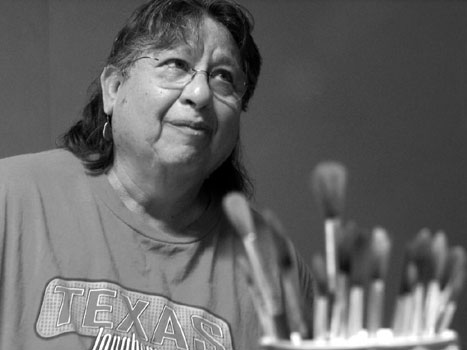
Portrait of an Artist – We were asked to make portraits expressing both the character and the work of the subject. I spent a while photographing Peña peering at us through softly focused brushes in the foreground. He was an excellent subject for this assignment, but his vivid orange shirt proved to be a distraction. When I converted this portrait to black and white with Photoshop, it became a simpler, stronger image.

Spools as Tools – Peña's wife, J.B. Boles-Peña, is also an artist. Rather than showing the textiles she creates, I decided to feature her tools, some of the many spools of thread, as another one of my close-up assignments.
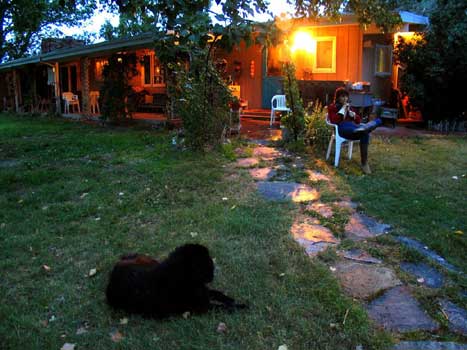
Evening Comes to the Ranch – Our final assignment at this Santa Fe ranch was to make an environmental portrait of owner J.B. Boles-Peña sitting outside of her house at dusk. In the golden glow of a porch light, I used a technique called "layering" that Nevada Wier often features in her own work. This picture is organized around three layers of meaning: a black dog anchors the foreground, the subject of the portrait relaxes in the middle ground, and the ranch house provides context in the background. A flagstone path diagonally leads us through the entire photograph.
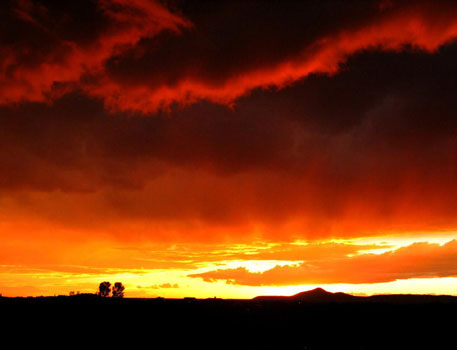
Stormy Sunset – Sunsets can make pretty pictures, but often are clichés. Our instructor suggested incorporating other elements into sunset pictures to enhance the meaning of the moment. I had an opportunity to practice this suggestion during a class visit to her Santa Fe home. We were treated to a spectacular evening sky following a rainstorm. I used a pattern of horizontal bands to organize my picture and make it go beyond the typical sunset. Two trees in the distance create a focal point, and suggest, through scale contrast, the vastness of this scene. The distant mountain is also diminished in size, adding additional contrast in scale. A band of intensely golden clouds provides high contrast lighting to both trees and mountain. Another band of falling rain descends from the dark, feathery clouds at the top, crowning this stormy landscape of the American Southwest. 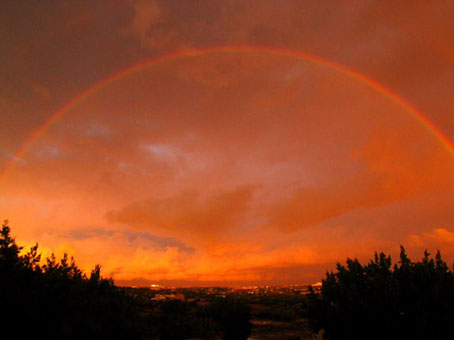
Rainbow over Santa Fe – Another important principle learned in this workshop is to concentrate not only on what may be in front of us, but also behind us. While shooting the previous photograph of the sunset over Nevada Wier's backyard, a rainbow was soaring through the sky in front of her house. Rain was still falling as light from the setting sun illuminated the clouds behind this rainbow. The sun's golden light, displayed in many shades of color, offers a breathtaking context for this rainbow, and my wide angle lens embraced its huge arch. Such picture opportunities as this offered a memorable lesson: good pictures are all around us.
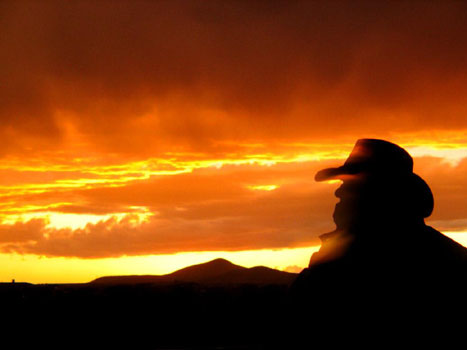
Sunset Portrait – Taking advantage of the spectacular Santa Fe sunset, Nevada Wier dressed up in western costume and posed for us on her back deck. Some participants illuminated her with fill-flash, while I used natural light to abstract her via a silhouette. The flare of the setting sun turns her into a symbol of the old west, a living monument to Santa Fe's historic past.
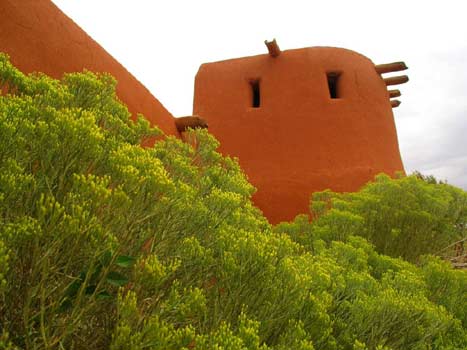
Fort, El Rancho de las Golondrinas – We visited a "living history" village evoking Santa Fe's colonial era and were given only an hour to capture a sense of the place. One of the buildings I photographed was this old adobe fort. I placed my camera close to a mass of bright green plants, creating a strong contrast in both color and texture to emphasize how this looming fort still guards the land.
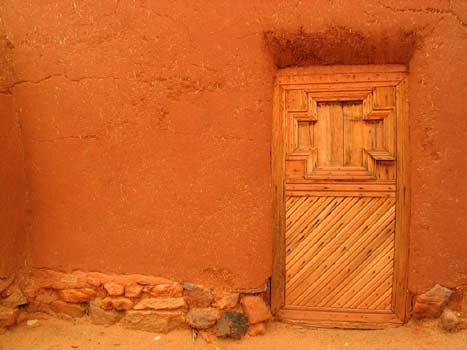
Old Door, El Rancho de las Golondrinas – Another assignment was to express the flavor of the Spanish Colonial era through detail and color. These rich colors and the geometric design of this old door best captured that flavor for me.
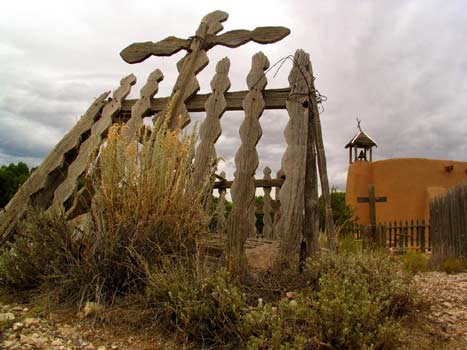
Grave, El Rancho de las Golondrinas – One of the most historic ranches in the America Southwest, Santa Fe's El Rancho de las Golandrinas offers insights into the town's Spanish Colonial culture. Its windswept cemetery, known as Campo Santo, as well as its old Penitente Meeting House, took me back in time more than any place I've visited in New Mexico. To capture this scene, I placed my camera and its 24mm wide angle converter lens on the ground only a foot or two behind a teetering wooden fence enclosing the 19th century grave. I shifted my position a few inches to the right to also include the old Meeting House in the background. My low vantage point also emphasizes storm clouds that would soon sweep the area with much needed rain.
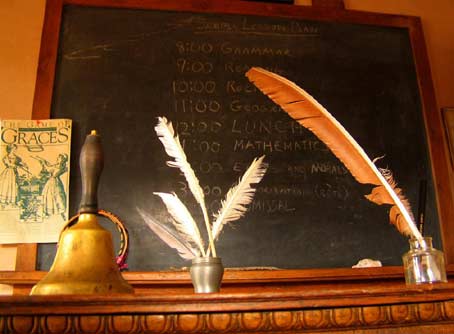
Schoolroom, El Rancho de las Golondrinas – Instead of showing an entire classroom in this 19th Century schoolhouse, I chose to symbolize the nature of this school by featuring a few of the tools used by teachers in those days. A bell, a blackboard, and a few quill pens take us back to another time and place. In travel photography, less can often be more.
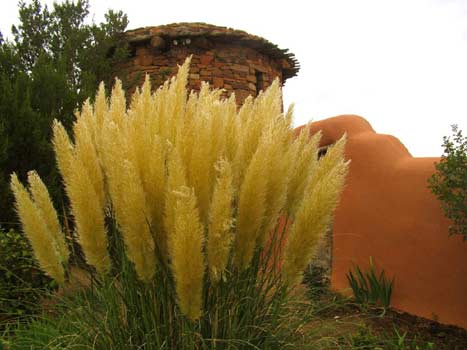
Grasses, Rancho de las Golondrinas – Much of our workshop emphasized the importance of light: its warmth, color, and contrast. But as is often the case, in travel photography we can't always have what we want. At Rancho de las Golondrinas, we had to work under gray skies, which create low contrast. We learned that low contrast offers its own opportunities such as the ability to capture rich colors and textures without worrying about distracting shadows. These feathery plumes of golden wild grasses contrast to the stones of the old stone tower and adobe wall in the background.
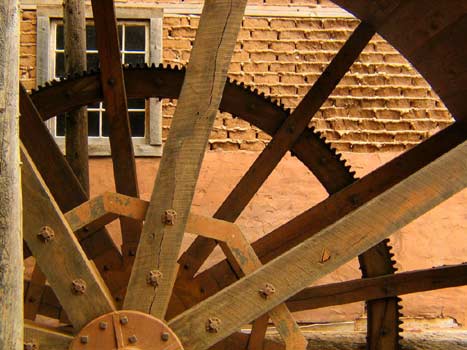
Water Wheel, El Rancho de las Golodrinas – In the 18th and 19th centuries, power was generated from the movement of water through this huge wheel. Although the skies were leaden, I was able to create contrast in light and shadow to bring out the patterns created by the wheel. Recognizing and using patterns in travel photography was a reoccurring assignment in this workshop.
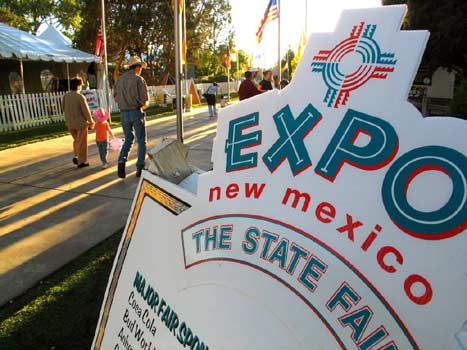
New Mexico State Fair, Albuquerque – Our final set of workshop shooting assignments involved capturing the magic of the New Mexico State Fair in pictures. This is my "establishing shot", inviting viewers to follow these fairgoers streaming through the fair's gates.
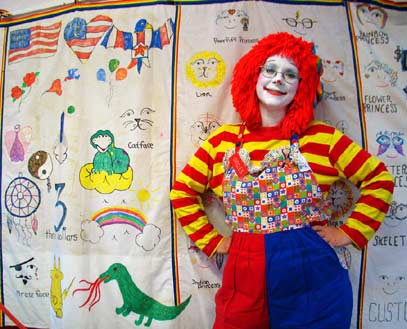
Giggles, New Mexico State Fair – One of our assignments at the fair was environmental portraiture, a staple of travel photography. We had to convince strangers to pose for us, and place them in settings that tell us who they are and what they do. I spent a half hour with Giggles, who offers a face painting concession at the fair. This shot is all about color and gesture, and her "menu" of faces made a perfect setting.

Portrait of a Portrait – A portrait within a portrait offers whimsical subject matter at New Mexico's State Fair. I stood behind these artists as they worked, relating them, as well as their desks and cash register, to the smiling couple they are portraying. This is another "layered" picture. The foreground thrusts the viewer into the picture, the middle ground features the subjects, and the colorful backdrop offers context.

Fun at the Fair – Clutching a bag of popcorn and wearing a cowboy hat, this young fellow enjoyed posing for Santa Fe Workshop photographers at New Mexico's State Fair. Using a colorful background of stacked hats, other photographers set up their shots as straight-on environmental portraits. I crouched off to one side, and used a low camera position to capture his enthusiastic response and make the towers of hats stacked behind him seem to soar as high as his spirits.
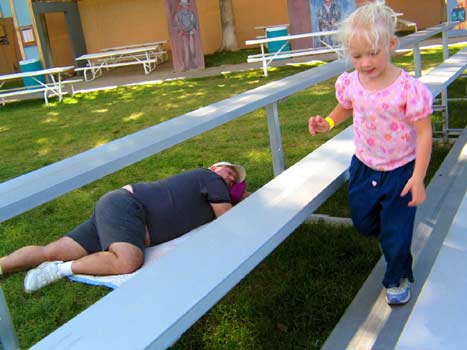
Dozing Dad – I saw this exhausted fellow taking a nap on the grass behind bleachers set up for a seal show at the New Mexico State Fair. A little girl kept running back and forth in front of me. I couldn't resist bringing these two elements together to add a touch of visual incongruity to my day's work at the Fair.
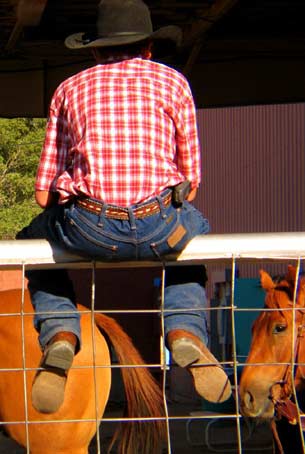
Picture Story: Opening Shot – Our most complex workshop assignment at the New Mexico State Fair was a picture story involving anywhere from three to seven images. I built my story around a day at the fair's riding competition. This opening shot was made in the corral behind the riding arena. We can't see this young rider's face, but we know what this story is going to be about.
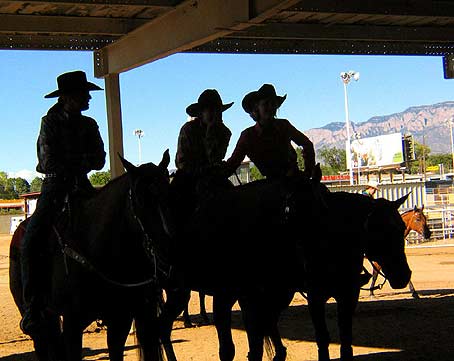
Picture Story: Waiting – Those who compete for riding honors at New Mexico's State Fair spend a lot of time waiting for their five minutes of fame. I abstracted these three riders with back lighting just before they were to enter the arena, emphasizing their body language as they nervously await the competition.
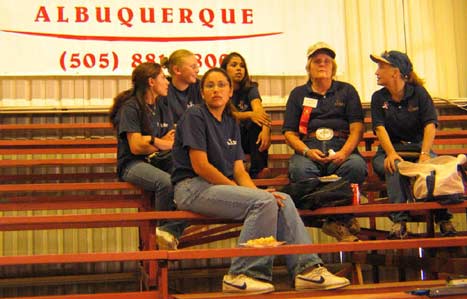
Picture Story: Friends and Family – Each competitor in the Fair's riding competition had their own rooting sections. In this, the third image of my picture story, I reveal faces for the first time, faces filled with varying degrees of emotion ranging from boredom to anxiety.
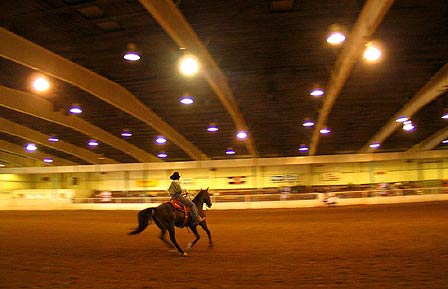
Picture Story: The Moment of Truth – Contestants in the riding competition get only a few moments to show how well they can make their horses perform. I used a wide angle lens to contrast the size of this lone rider to the vast arena. Blur caused by my slow shutter speed brings a sense of motion to both the background and horse.
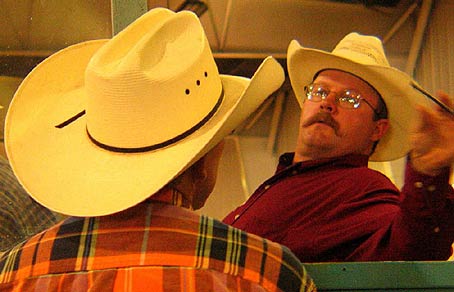
Picture Story: Judgement – I moved close to two judges as they decided the fate of an entrant in the riding competition. By shooting one of them from behind, everyone who looks at this picture becomes an eavesdropper on this conversation. My slow shutter speed blurs the hand gesture of the judge at right. He seems to be vigorously making his point.
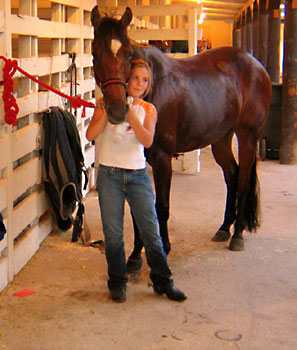
Picture Story: Closing Shot – Hours after I left the riding arena, I still did not have an effective closing shot. In the evening, I went back to the horse barns, where I found this young rider tending to her mount. I have no idea how she performed, but I am sure that she will never forget this day at the fair. I wanted this environmental portrait to express a sense of pride and contentment. It turned out to be the perfect closing shot for my picture story assignment.
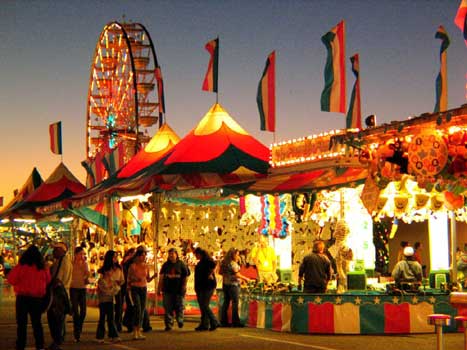
The Midway, New Mexico State Fair – My next to last assignment at the Fair was to create a shot between sunset and darkness that would capture the glitter and excitement of the New Mexico State Fair. I chose this spot on the Fair's Midway to create a picture featuring three layers of meaning. I waited until the crowds in the foreground created a horizontal flow of individuals moving across the base of the picture. The middle ground features booths bathed in rich color and topped with fluttering flags. The background layer holds a towering Ferris wheel, placed off center and framed against the glowing evening sky. This shot, hand-held at ISO 400, gave me everything I was looking for.
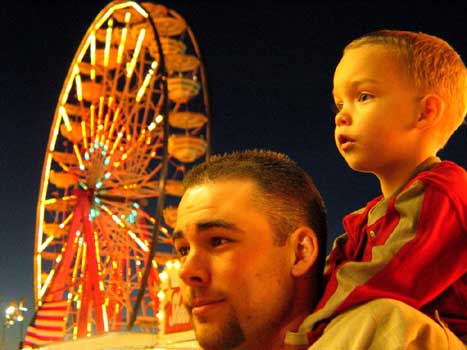
Finale: Night Falls on the Fair – The sky has turned from blue to black. I had to make a night shot that added an exclamation point to this day's adventure in digital photography. Once again, I chose to feature the Ferris wheel in my picture. Only this time, I placed it in soft focus by moving in on a man and his son, waiting patiently to board one of the Fair's rides. This image was the last of my environmental portraits as well as my final shot of the New Mexico State Fair. It also became the last picture I would make in the workshop itself. It was a good way to go out.
Note: For additional information you may contact:
Santa Fe Workshops
PO Box 9916
Santa Fe, NM 87504-5916
Voice: (505) 983-1400
Fax: (505) 989-8604
info@santafeworkshops.com
www.santafeworkshops.com







































